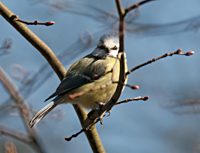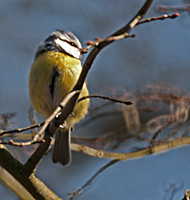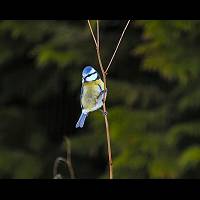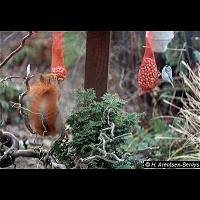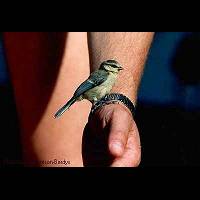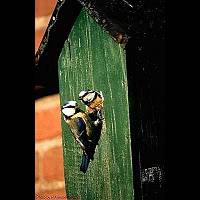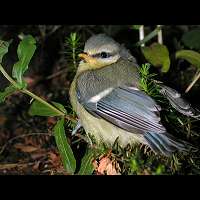[All pictures of garden wildlife on this page are thumbnails. Click on any thumbnail for a large format to be displayed.]
The Blue Tit (Cyanistes caeruleus)
Click![]() here for the bird's sound.
here for the bird's sound.
Blue Tits are blue and yellow, very curious titmice. They are ready to breed in the smallest garden.
This little and very colourful bird is one of the most popular to have in one's garden. It's the only bird in Holland that is just blue and yellow. The bird is very acrobatic, lively and extremely intelligent. In England it is known to open milkbottles in order to get to the fat on top of the milk. In wintertime it will surely appear in one's garden and it will show off it's acrobatic abilities to gain the food, like the peanuts-in-a-net above. In wintertime is's often accompanied by other tits like the Great Tit and the Coal tit. The Blue Tit is also a bird that can easily be tempted to build it's nest in your garden. Just provide it with a box... You should mind though that the opening isn't too large, for then the Great Tit will push out the Blue one. It's not common for any tit too be so trusting of people that they sit on your hand. This picture was taken under peculiar circumstances. In our garden we have a pond. We recommend every bird lover who has a garden to make a (little) pond. Birds need to drink water regularly and many also love to bath! It's also a good way to see birds that you normally only hear. Many birds are rather shy towards people, others are not, but live high up in trees and are therefore hard to spot. A pool however is a temptation hard to resist and even those hard-to-spot birds will show their interest. Now when birds leave their nest for the first time they are not the best of flyers and it sometimes happens they don't know what a pond is or try to sit on a twig just above the pond that is too fragile to hold their weight and consequently they fall into the water. That's what happened to the very young Blue Tit above. Now when either my wife or I see that happening, we rush out and take the little snotnose from the water. And especially during cold and rainy summers we take them into the house until they are all dried up. It's during such a period that they are very calm (probably almost unconcious) and you can have them sitting on your hand like here. By the way: don't stroke or pet them. Birds don't like that at all and many will even panic!
Blue Tits are fine little birds. They are almost cheeky like Robins...
In wintertime we feed our little feathered friends and among the first to appear in larger numbers are the Blue Tits. When the food is just distributed they may fight a bit about the newly discovered place, but they soon give up on that and all eat happily together. Because we live in an area with lots of trees squirrels also show interest in the peanuts. Once the squirrel appears all birds fly off and wait for the animal to disappear again. Only a few very brave birds keep right on feeding. The Blue Tit in the picture above shows great courage, for a squirrel will certainly eat a bird if given the chance... Below are pictures of a very young Blue Tit that has just left it's nest. Although it can fly it still has lots of difficulties with that ability. Especially young ones illustrate why they are called Blue Tits. When they get older the yellow shows more, but for now blue is certainly the predominant colour. The pictures are bigger than ususal: 1024 x 768 pixels. You should watch them in full resolution. If your browser makes them smaller, please blow them up, for they look awful being made smaller.
This is a young Blue Tit. When it gets older it will become more yellowish.
This bird belongs to the family of Titmice or Chickadees (Pariidae). It is very common in our garden and can be seen in Holland all year round. The bird is 4" and weighs 11 grams. It lives in woodlands, parks and gardens mostly. It eats insects and little seeds. The sexes do not differ from one another. The birds make their nest in april or may, usually in tree, but artificial opportunities for breeding are gladly accepted. The bird produces an impressive number of eggs, seven to fourteen! The time it spends sitting on the eggs is relatively long for such a small bird: two weeks. It takes the hatchlings about 17 days to be able to leave the nest.
| Name of this bird in other languages | ||||
| Dutch | German | French | Polish | Scientific |
| Pimpelmees | Blaumeise | Mésange bleue | Sikorka modra of Modraszka | Cyanistes caeruleus* |
* Used to be called Parus caeruleus, but has been placed in the genus Cyanistes recently.

© Copyright 1998-2024 gardensafari.net (Hania Berdys)

 English / engels
English / engels  Dutch / nederlands
Dutch / nederlands